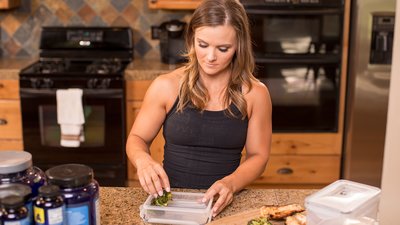You've seen them on Instagram: the hardcore athletes who line up a week's worth of meals on a kitchen counter, snap a picture, and proudly tag it #moregains, #fitfood, and #goals. But who's got time to do that except professional bodybuilders, right? You're doing fine just going from meal to meal without planning! Or are you?
Here's the thing: Meal prepping doesn't have to be the all-or-nothing Tupperware party that many people portray it as. It could be a total game changer for your results even if you just prep your most problematic meal of the day (for most people, lunch), and your post-workout meal, which can be nothing more than a snack or a protein shake.
If those two meals happen to be the same meal for you, all the better! Let's dive in and get you on the road to easy, effective prep.
Is Prepping Really Worth the Time?
"More than anything, meal prepping allows you to plan your meals based on your health and fitness goals," says Josh Davis, CSCS, a strength coach and self-proclaimed master meal-prepper. "Meal prepping will get you better, quicker results from your training. It puts you in control of what you eat, when you eat, how much you eat, and when you 'cheat.'"
Taking the time—and making the time—to prepare as little as 3-5 meals each week could be just the thing to bring your entire week of eating under control.
"Meal prep helps you manage temptations that arise throughout the day," says Davis. "It helps save time. It reduces the effects of 'decision fatigue,' and allows you to create an organized schedule of eating that fits the pace of your day, even if you're incredibly busy."
If you put in the time and energy to prep nothing more than your lunches, snacks, and post-workout meals or shakes, you're that much less likely to head through the drive-thru. Prepping also cuts down on wasted food and wasted time, because you're buying and preparing only what you need.
Shop With Specific Meals In Mind
All the hard work of meal prepping comes on the front end.
"Look at your schedule for the week and determine how many meals you really need before you head to the grocery store," says Talia Koren, founder of Workweek Lunch, an Instagram site that helps meal preppers prep.
Once you've determined how many meals you need, think about what you really like to eat.
"Cook healthier versions of the food you like to order at restaurants. Instead of settling for drab chicken and broccoli, aim for dishes like burrito bowls, Asian stir-fries, or even pasta dishes," Koren says.
Of course, preparing to cook more interesting meals means you need to select recipes before you head for the store. This doesn't have to be complicated. Here are two tried-and-true approaches:
- Choose recipes that use some of the same ingredients, so you can cook up a bunch of chicken to use in different dishes one week. Then plan on multiple—but different—beef dishes the next.
- Change up the meats every other day while keeping your sides dishes the same. So beef and rice one day, pork tenderloin and rice the next. The more you're able to cook at once, the less prep and cleanup time you'll need.
Shop, Then Prep Right Away
Plenty of people shop with an ambitious prep in mind, but once they get home, they put the food in the fridge and go do something—anything—other than prep. Often, the food they buy ends up going to waste, and they end up dreading meal prep or thinking they don't have time for it.
Work efficiently by carving out one single time to do your shopping, prepping, cooking, and storing. For instance, as soon as you get home from the store, immediately wash and cut your veggies, light up the stove, and start cooking.
"Keep it simple when you first start," Davis says. "Plan and prep one meal and one snack a day and give yourself time to master the process. Get a feeling for how much food you need for a week's worth of one meal a day. Once you master the process, you can start prepping multiple meals, but don't rush right into it."
Make Meals You'll Be Able to Eat
When you're planning your meals, consider the resources you have at work. If your workplace doesn't have a microwave, avoid meals that need to be heated. Instead, prep cold salads, stir-fries that hold up well when served cold, and simple finger foods.
If you do have access to a microwave, the culinary world is your oyster. Just make sure the containers are heatproof. It's best to use actual bowls made of thick plastic, ceramic, or glass to heat up things like soup. But be careful taking these containers out of the microwave: They can get very hot!
Think Specifically About Your Post-Workout Nutrition
One of the best reasons to meal prep is to get your post-workout nutrition right. In addition to standard meals and snacks, take any post-workout supplements you take into consideration.
"The food you eat after a workout is your 'recovery meal,'" says Lisa Reed, CSCS, IFBB fitness pro and owner of Lisa Reed Fitness. "This small meal is the most important and underrated part of training. Within 15-30 minutes after exercising, your muscles are like sponges and will soak up nutrients like a dry sponge soaks up water."
Not coincidentally, right after training is also often when people who struggle with their diet find themselves attacked by cravings. Having a solid, balanced meal on hand is essential at this time!
For a seriously simple approach to the recovery meal, add a post-workout snack that's rich in carbs and protein to your meal prepping plan, especially if you can't sit down to eat within a couple hours after your scheduled workout. Throw one or two snacks into your meal prep carryall, along with a shaker bottle and some protein. When you've finished your workout, simply toss back a shake and eat your snack. Then, an hour or two later, have your full meal.
Keep Your Meals Cold When You're On the Go
Standard lunch boxes or bags are fine if you're carrying a single meal with you, but if you've got three meals, two snacks, and supplements, a basic lunch box won't cut it. Many companies now cater to meal preppers, offering specialized bags designed to hold multiple meals and additional gear. These bags are typically insulated and come with their own food containers and ice packs to make food prep a seamless endeavor.
This might seem like overkill to someone new to prep, but plenty of fit people swear by them. Why? They make your life and your prep easier—which shouldn't be underappreciated. If you're going to get serious about prep, it may be an investment worth making.
One of the most popular meal prep companies, 6 Pack Fitness, offers bags with a shelving system that allows you to access individual meal containers without removing anything else from the bag.
Michael Todd, a 6 Pack Fitness representative, recommends the Innovator Mini for people new to the prepping game. The Innovator Mini comes with three containers for meals and snacks, and one for supplements. There's also enough room for two shaker bottles. The containers sit inside an insulated shell that comes with two freezer packs that can keep food cold for eight or more hours.
Think Five Days Out
Some meal preppers like to get a whole week ahead. Others like to limit it to 2-3 days, and prep twice a week. Casey Moulton, also known as the Kitchen Karate guy, recommends that new preppers think in terms of the five-day work week at first.
"I recommend making fresh meals each week and storing them in the refrigerator," says Moulton. "Most meals will hold up for five days in the fridge without a problem, which is usually as long as you need to store them."
If you find that the last couple of meals each week aren't quite up to par, either cut back to a three-day prep, or try to pick meals that lend themselves to sitting for slightly longer.
Moulton also recommends prepping and storing individual components of meals. For instance, all the chicken goes in one container, the beef in another, and the sweet potatoes in a third. Then, you can mix and match them throughout the week.
To help foods last longer, make sure the lid is tight, Moulton says, and keep things like lettuce and spinach packed separately from liquids. Throw a paper towel in with your leafy greens to keep them from getting soggy.
What about freezing meals? None of the experts I interviewed recommended that approach for the beginning meal prepper. Yes, it can be an occasional lifesaver to have a frozen meal waiting for you when there's nothing else planned, but for most people, starting with lunch and the post-workout snack or meal is the path of least resistance.
Just Get Started!
At the end of the day, the best way to learn is by doing. If you have a plan, a few solid containers, and a carrying case, you've got what you need to give meal prepping a try. All that's left to do is head to the grocery store, sharpen your kitchen knife, and get to work.

